Operators’ Load Monitoring and Management
Abstract
1. Introduction
1.1. Motivation
1.2. Contribution
2. Materials and Methods
2.1. Influence of Automation on Loads of Operators
- designers must find the optimal examining solutions for indicating the measurements and information, namely presentation in analogue or digital forms,
- the applied display may show too many and rather different information during a short time,
- new, highly automated cockpit instrumentation and the working environment of pilots increase the role of the mental load and brings in new types of load, information and communication overload.
2.2. Operator Models
- The task load indicates the degree of difficulty and hardness when executing a task such as traffic regulations, traffic demands, area design and other task demands. In the case of highly automated systems, changes in traffic intensity and abnormal and emergency situations may generate several extra tasks. This load can be assessed by the “NASA Task Load Index” (NASA-TLX) [35].
- The workload is defined as the total amount of work by an operator in a specific time period as it depends on both human factors (human behaviour, skill, tacit knowledge, experience, etc.) and external factors (traffic regulation, traffic planning, weather condition, etc.). Several techniques have been proposed for measuring and evaluating operator loads. The most well-known measuring techniques are the following: (i) “Situation Awareness Global Assessment Technique” (SAGAT) [36], (ii) “Situation Awareness Rating Technique” (SART) [37], (iii) “Automation Thrust Index” (SATI) [38], (iv) Subjective Workload Assessment Technique (SWAT) [39], and (v) Workload Profile (WP) [40].
- As an operator workplace environment becomes increasingly complex, the amount of information gained from vehicle systems is also increased. The automated vehicle systems provide too much information to operators from different sources. The amount of information creates confusion among operators. Information load, therefore, was created and included in the Endsley load model. This load depends on traffic regulation, weather condition and other aspects.
- Communication load can be defined by the level of understanding between operators which depends on language, cultural norms, and social relations. This load, therefore, is included in the Endsley load model as well (Figure 4).
- Mental load is the physical and psycho-physiological condition of operators and strongly depends on human aspects (behaviours, skills, knowledge, experience, physical and psychophysical condition). The quality of situation awareness and decision-making process is directly affected by the mental load of operators. In the literature, numerous articles have been published in the field of mental load [42,43]. The mental load of operators is measured by using medical and physiological devices.
2.3. Sensor Integration into the Working Environment and Experiment Details
- passive—built into the environment for a distance from the operators, like eye tracking, infrared and cameras, etc.,
- passive-integrated—sensors integrated into the working environment for direct sensing of the operators’ behaviours (such as heart rate, and skin resistance, etc.) built into the operators’ control elements or their clothes,
- semi-active sensors—measuring some characteristics such as the reactions of operators on some signals, and information, etc.,
- active—such sensors that measure the reactions of the operators in response to the specially generated signals (including signals initiated for testing the system and operators).
- (i)
- Participants
- (ii)
- Experiment Design
- Scenario 1: Visual Meteorological Conditions (VMC): This is an aviation flight category in which visual flight rules apply; expressed in terms of visibility, ceiling height, and aircraft clearance from clouds along the path of flight. In this category, pilots have sufficient visibility to control the aircraft by mostly looking out the window. It is entirely the pilot’s responsibility to navigate the aircraft, maintain visual separation from terrain and other aircraft during operation, and find an airport to safely land.
- Scenario 2: Instrument Meteorological Conditions (IMC): This is an aviation flight category that requires pilots to conduct most of the operation by looking at the flight instruments on the control panel rather than by looking out the window under visual flight rules (VFR). This category requires pilots to have more flying skills, tacit knowledge and experience.
- Scenario 3: IMC with Attitude Directional Indicator (ADI) failure: In this scenario, pilots control the aircraft under Instrument Meteorological Condition (IMC) with Attitude Directional Indicator failure. This scenario is the most difficult task for a pilot to carry out.
- (iii)
- Task Protocol
- Take-off from RWY 25L
- Set power for take-off (Manifold pressure 40)
- Airspeed (blue line speed)
- Set 300 feet AGL-Above Ground Level gear up flaps up, set climb power (manifold pressure 39, RPM-Revolutions per min 2600), fuel pumps off, landing lights off
- Maintain runway heading (250°) until the aircraft reaches 1000 feet MSL-Mean Sea Level
- Climbing right turn to heading 340°
- Stop climbing at 2500 feet and turn right to heading 070° for downwind.
- Fly straight on downwind
- Maintain 2500 feet
- Configure the aircraft for the cruise (Manifold pressure 22, RPM 2400)
- Approach and land on RWY25L
- Reduce power for approach (RPM forward, throttle pull back as required), fuel pump on, landing lights on
- Turn right to HDG-Heading 160°
- Set approach flaps and gear down when airspeed is in the white arc.
- Approach speed: blue line speed
- Land on RWY 25L
- Stop on the runway
| No | Name | Performance | Possible Application | Integration into Working Environment |
|---|---|---|---|---|
| 1 | TOBII Eye-Tracker | Area of interest, Gaze points, Eye movement Fixation duration | Psychology research (the mental state of operators), Level of operator loads, Human behaviour, Attention level, Performance at the cognitive level | 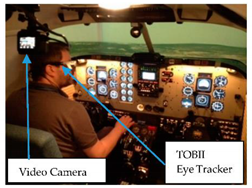 TOBII Eye-Tracker Usage |
| 2 | Skin Resistance Sensor (a) kin Temperature Sensor (b) Heart Rate Sensor (c) | The resistance of skin (a), Temperature of skin (b), Heart rate (c) | Physiological indicators, Stress level, Emotional state, Mental state, Task difficulty |  Integrated sensors [53] |
| 3 | OBIMON (Open Source Bio-Monitor) Electrodermal Activity Device (EDA) | Sweat gland activity by taking into account the “Skin Conductance Level” (SCL) | Arousal level, Stress level, Anxiety level, Mental state, Task difficulty, Operator loads | 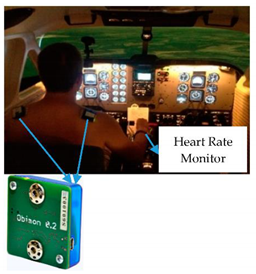 EDA-OBIMON [55] device usage in the flight simulator environment |
| 4 | Microsensor, Motion and Video Cameras | Eyeblink, Eye movement | Behaviour, Attention level, Performance at the cognitive level, Task difficulty |  Video camera usage in the simulator laboratory |
| 5 | Binocular | Providing a magnified stereoscopic view of distant objects, and improve visual acuity | Level of operator loads, Task difficulty | 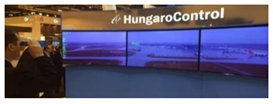 Binocular Usage at HungaroControl [97] |
| 6 | Load - Tracking Seat Cushion | Fatigue level | Reaction time, Behaviour, Attention level, Performance at the cognitive level, Level of operator loads | Load-Tracking Seat Cushion Usage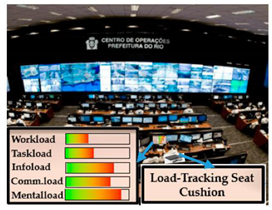 Rio Operation Center Contol Room [98] |
| 7 | Functional Near-Infrared (fNIR) Spectroscopy | Monitor cerebral hemodynamic changes within the prefrontal cortex in response to the sensory, motor, or cognitive activation. | Mental load assessment in a complex work environment | 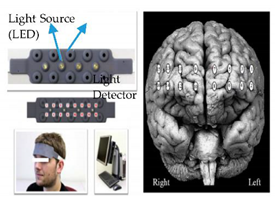 fNIR sensors (right) [99] |
| 8 | Electrocardiogram-ECG (a), Electroencephalography-EEG (b) Electromyography (EMG) (c) Event-Related Brain Potentials (ERPs) (d) | The electrical activity of the heartbeat (a), Electrical impulses of the brain (b), Electrical activity of nerves and muscles (c, d), | Level of operator loads, Task difficultly, Psychological state, Info. Processing, Emotional level, Cognitive processes in the brain | 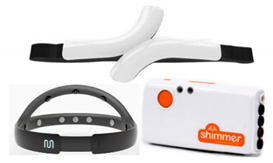 Wearable ECG [100] (top), EEG [101] (left-bottom) and EMG [102] (right-bottom) Monitors |
| 9 | Breathing-Respiration Sensor | Respiration rate Respiration volume | Mental state, Stress level, Load assessment |  Respiration Sensor [103] |
| 10 | Force Myography (FMG) and Muscle Strength Sensors | Position and movement of limbs Muscle movement | Stress level, Operator load assessment | 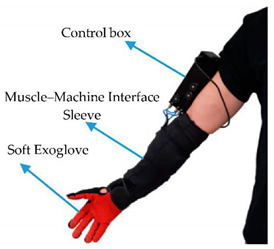 The muscle–machine interface consists of a soft, wearable sleeve that accommodates multiple Force Myography (FMG) and Electromyography sensors [104]. |
| 11 | Blood Oxygen Saturation Sensor | Pulse rate and pulse percentage of haemoglobin in the blood that is saturated with oxygen | Mental state, Stress level, Task difficulty, Operator load assessment |  Pulse Oximeter and Heart Rate Monitors [105] |
2.4. Data Processing
- preliminary data processing—filtration, reducing the effects of measured noise,
- detection of crossing the limits—generating warning signals based on crossing the limits by the measured signals,
- evaluation of the change rates in measurements—with detection of the crossing the limits for change rates,
- analysis of the signals’ shapes—including estimation of the maximum deviation, frequency of changing processes, comparison with the standard processes of changing (including changing according to the test signals in active measurements, and active monitoring),
- statistical and trend analyses—estimating the statistical characteristics and parameters of the trends,
- using the approximation formulas—developed especially for these purposes,
- identification of the model parameters—like the transition function of the operators.
2.5. Operator Load Monitoring Concept
2.6. Operator Load Management Concept
- If one of the operator’s load reaches the threshold where the score is: (i) 0.8—a warning signal must be generated, (ii) 0.9—calling special attention to continuously monitoring the operating condition, and (iii) 0,95—immediate actions are required (Figure 9, left).
- Combination of at least two loads, namely in a case when any two types of load coefficients, reach to 0.7 or above (Figure 9, right): (i) 0.7—warning, (ii) 0.8—monitoring, and 0.9—immediate action required.
- If one of the operator loads drops to the threshold where is the score: (i) 0.2—a warning signal must be generated, (ii) 0.1—calling the special attention to continuously monitoring the operating condition, and (iii) 0.05—immediate actions are required (Figure 10, left).
- Combination of at least two loads, namely in a case when any two types of load coefficients drop to 0.3 or below: (i) 0.3—warning, (ii), 0.2—monitoring, and 0.1—immediate actions required (Figure 10, right).
- In the case of the operator overload situations: 0.8 (a warning signal must be generated), 0.9 (calling special attention to continuously monitoring the operating condition), and 0.95 (immediate actions are required).
- In the case of the operator underload situations: 0.2 (warning signal must be generated), 0.1 (calling the special attention to continuously monitoring the operating condition), = 0.05 (immediate actions are required).
3. Results
3.1. Typical Operator Load Measurements
3.2. Load Monitoring Concepts for Pilots and ATCOs
4. Discussion
4.1. Evaluation of the Results
4.2. Load Management Concept Validation
5. Conclusions
Author Contributions
Funding
Acknowledgments
Conflicts of Interest
References
- European Commission. EU Road Safety Policy Framework 2021–2030—Next Steps Towards “Vision Zero”; 2019; Available online: https://ec.europa.eu/transport/sites/transport/files/legislation/swd20190283-roadsafety-vision-zero.pdf (accessed on 15 July 2020).
- Ertico, A.C. ESafety Recommendation Note. 2006. Available online: https://docbox.etsi.org/stf/archive/stf321_tispan3_ec_emergency_call_location/public/library/e-Call/Progresson28Recommendations(updated December 2006).pdf (accessed on 14 August 2020).
- SIEMENS. The Future Car: Driving a Lifestyle Revolution. 2018. Available online: https://www.plm.automation.siemens.com/media/global/en/Siemens-PLM-SES-Future-Car-wp-69077-A11_tcm27-31327.pdf (accessed on 15 August 2020).
- SESAR. Consortium. European ATM Master Plan, 2nd ed.; Roadmap Sustainable Air Traffic Management; 2012; Available online: https://www.sesarju.eu/sites/default/files/documents/reports/European_ATM_Master_Plan_Ed-2_Oct-2012_0.pdf?issuusl=ignore (accessed on 17 July 2020).
- The Joint Planning and Development Office. Next Generation Air Transportation System Integrated Plan; 2004; Available online: https://apps.dtic.mil/dtic/tr/fulltext/u2/a605269.pdf (accessed on 17 July 2020).
- Collaborative Actions for Renovation of Air Traffic System (CARATS). Long-Term Vision for the Future Air Traffic System, Changes to Intelligent Air Traffic Systems; 2010; Available online: https://www.mlit.go.jp/common/000128185.pdf (accessed on 2 August 2020).
- SIRIUS. Impulsionando o Desenvolvimento do ATM Nacional A Aviocao do Future jo Comecou; 2013. Available online: https://www.decea.gov.br/sirius/index.php/o-sirius/o-sistema-atm/?lang=en (accessed on 21 July 2020).
- Parasuraman, R.; Sheridan, T.B.; Wickens, C.D. A model for types and levels of human interaction with automation. IEEE Trans. Syst. Man Cybern. Part A Syst. Hum. 2000, 30, 3. [Google Scholar] [CrossRef]
- Kale, U.; Tekbas, M.B. Operator’s Subjective Decisions-Improving the operator’s (Pilot and Air Traffic Control) decision making. Sci. Coop. Int. J. Mech. Aerosp. Eng. 2017, 3, 43–51. [Google Scholar]
- Wangai, A.W.; Rohacs, D.; Boros, A. Supporting the sustainable development of railway transport in developing countries. Sustainability 2020, 12, 3572. [Google Scholar] [CrossRef]
- Aygun, H.; Turan, O. Entropy, Energy and Exergy for Measuring PW4000 Turbofan Sustainability. Int. J. Turbo Jet Engines 2019, 3. [Google Scholar] [CrossRef]
- Cilgin, M.E.; Turan, O. Entropy Generation Calculation of a Turbofan Engine: A Case of CFM56-7B. Int. J. Turbo Jet Engines 2018, 1–3. [Google Scholar] [CrossRef]
- Chialastri, A. Automation in aviation. Automation 2012, 79–102. [Google Scholar] [CrossRef]
- Archer, J.; Keno, H.; Kwon, Y. Effect of Automation in the Aircraft Cockpit Environment: Skill Degradation, Situation Awareness, Workload; 2012; Available online: https://pdfs.semanticscholar.org/a90a/7a1dc3828eb34e79a40accf771e7c545445f.pdf (accessed on 27 July 2020).
- FAA. Concept of Operations for the Next Generation of Air Transportation System; Technical Report; 2010; Available online: https://apps.dtic.mil/dtic/tr/fulltext/u2/a535795.pdf (accessed on 13 May 2020).
- Rohacs, D.; Jankovics, I.; Rohacs, J. Development of an Advanced ATCO Workstation. In Proceedings of the 30th Congress of the International Council of the Aeronautical Sciences (ICAS), Daejeon, Korea, 26–30 September 2016; pp. 1–8, ISBN 9783932182853. [Google Scholar]
- Rohacs, J. Subjective aspects of the less-skilled pilots, performance, safety and well-being in aviation. In Proceedings of the 29th Conference of the European Association for Aviation Psychology, Budapest, Hungary, 20–24 September 2010; pp. 153–159. [Google Scholar]
- Jankovics, I.; Kale, U.; Rohacs, J.; Rohacs, D. Developing ATCOs support system: Load management, integrated sensors and eye tracking. Sci. Coop. Int. J. Mech. Aerosp. Eng. 2017, 3, 25–42. [Google Scholar]
- Tánczos, K.; Török, Á. Impact of transportation on environment. Period. Polytech. Transp. Eng. 2008, 36, 105–110. [Google Scholar] [CrossRef]
- Szabolcsi, R. Pilot-in-the-Loop Problem and Its Solution; Technical Science Applied Mathematics. Rev. Airforce Acad. 2009, 1, 12–22. [Google Scholar]
- First Aero Squadron Foundation. Cockpit Evolution—From the Beginning to Present. 2015. Available online: https://firstaerosquadron.com/2015/09/23/cockpit-evolution-from-the-beginning-to-present/ (accessed on 10 September 2019).
- Boeing. Innovation 787 Flight Deck Designed for Efficiency, Confort, and Commonality. Aero QTR_01 December 2012. Available online: https://www.boeing.com/commercial/aeromagazine/articles/2012_q1/3/ (accessed on 10 July 2020).
- Kellerer, J.; Möller, C.; Kostka, A.; Neujahr, H.; Sandl, P. Panoramic Displays: The Next Generation of Fighter Aircraft Cockpits. SAE Int. J. Aerosp. 2011, 4, 751–761. [Google Scholar] [CrossRef]
- Fojtík, J. Avionics—A Digital Revolution; Aerospace Central Europe: Prague, Czech Republic, 2019; Available online: https://aero-space.eu/2019/06/14/avionics-a-digital-revolution/ (accessed on 6 July 2020).
- Rohacs, J.; Jankovics, I.; Gal, I.; Bakunowicz, J.; Mingione, G.; Carozza, A. Small aircraft infrared radiation measurements supporting the engine airframe aero-thermal integration. Period. Polytech. Transp. Eng. 2019, 47, 51–63. [Google Scholar] [CrossRef]
- Pelt, M.; Stamoulis, K.; Apostolidis, A. Data analytics case studies in the maintenance, repair and overhaul (MRO) industry. MATEC Web Conf. 2019, 304, 1–8. [Google Scholar] [CrossRef]
- Bede, Z.; Péter, T. The development of large traffic network model. Period. Polytech. Transp. Eng. 2011, 38, 3–5. [Google Scholar] [CrossRef]
- Török, Á.; Szalay, Z.; Uti, G.; Verebélyi, B. Representing automated vehicles in a macroscopic transportation model. Period. Polytech. Transp. Eng. 2020, 48. [Google Scholar] [CrossRef]
- Hargitai, C.; Schweighofer, J.; Simongáti, G. Environmental impact of some retrofit options applied to an inland vessel. Period. Polytech. Transp. Eng. 2018, 46. [Google Scholar] [CrossRef]
- Hargitai, C.; Schweighofer, J.; Simongáti, G. Simulator Demonstrations of Different Retrofit Options of a Self-propelled Inland Vessel. Period. Polytech. Transp. Eng. 2019, 47. [Google Scholar] [CrossRef]
- Rajamani, R.; Saxena, A.; Kramer, F.; Augustin, M.; Schroeder, J.B.; Goebel, K.; Shao, G.; Roychoudhury, I.; Lin, W. Developing IVHM Requirements for Aerospace System. In Proceedings of the SAE 2013 AeroTech Congress & Exhibition, Montreal, QC, Canada, 24–26 September 2013; pp. 1–8. [Google Scholar] [CrossRef]
- Karakoc, T.H.; Colpan, C.O.; Altuntas, O.; Sohret, Y. Sustainable Aviation; Springer International Publishing: Berlin, Germany, 2019; ISBN 9783030141943. [Google Scholar] [CrossRef]
- Reason, J. Human error: Models and management. Br. Med. J. 2000, 320, 768–770. [Google Scholar] [CrossRef] [PubMed]
- Reason, J. Managing the Risks of Organizational Accidents; Taylor & Francis Group Publisher: Oxfordshire, UK, 2016; ISBN 9781134855353. [Google Scholar]
- Hart, S.G.; Staveland, L.E. Development of NASA-TLX (Task Load Index): Results of Empirical and Theoretical Research. Adv. Psychol. 1988, 52, 139–183. [Google Scholar] [CrossRef]
- Endsley, M.R.; Kiris, E.O. Situation Awareness Global Assessment Technique (SAGAT) TRACON Air Traffic Control Version User Guide; Lubbock Texas Tech University: Lubbock, TX, USA, 1995. [Google Scholar]
- Taylor, R.M. Situational Awareness Rating Technique (SART). The Development of a Tool for Aircrew Systems Design. In Situation Awareness in Aerospace Operations; Salas, E., Dietz, A.S., Eds.; Routledge: New York, NY, USA, 2016; pp. 111–128. ISBN 9780754629733. [Google Scholar]
- Dehn, D.M. Assessing the Impact of Automation on the Air Traffic Controller: The SHAPE Questionnaires. Air Traffic Control Q. 2008, 16, 127–146. [Google Scholar] [CrossRef]
- Reid, G.B.; Nygren, T.E. The Subjective Workload Assessment Technique: A Scaling Procedure for Measuring Mental Workload. Adv. Psychol. 1988, 52, 185–218. [Google Scholar] [CrossRef]
- Tsang, P.S.; Velazquez, V.L. Diagnosticity and multidimensional subjective workload ratings. Ergonomics 1996, 39, 358–381. [Google Scholar] [CrossRef] [PubMed]
- Endsley, M.R. Distribution of Attention, Situation Awareness, and workload in a Passive ATC task: Implications for Operational Errors and Automation. Air Traffic Control. Q. 1997. [Google Scholar] [CrossRef]
- Jankovics, I.; Kale, U. Developing the pilots’ load measuring system. Aircr. Eng. Aerosp. Technol. 2019, 91, 281–288. [Google Scholar] [CrossRef]
- Kale, U.; Jankovics, I.; Rohacs, J.; Rohacs, D. Load Monitoring for Operators’ Load Management. In Proceedings of the 31st Congress of the International Council of the Aeronautical Sciences (ICAS), Belo Horizonte, Brazil, 9–14 September 2018; pp. 1–10, ISBN 9783932182884. [Google Scholar]
- Flach, J. Designing Quality Experiences: Putting Humans into Control in Complex Work Domains, DesignX Workshop 20th October 2015; College of Design and Innovation at Tongji University: Shanghai, China, 2015. [Google Scholar]
- Marr, D. Vision: A Computational Investigation into the Human Representation and Processing of Visual Information; The MIT Press: London, UK, 1982; pp. 34–36. ISBN 0716712849. [Google Scholar]
- Wickens, C.D. Engineering Psychology and Human Performance, 2nd ed.; Harper Collins: New York, NY, USA, 1992. [Google Scholar]
- Cummings, R.W. The analysis of driving skills. J. Aust. Road Res. Board 1964, 1, 4–14. [Google Scholar]
- Boros, A.; Fogarassy, C. Relationship between corporate sustainability and compliance with state-owned enterprises in Central-Europe: A case study from Hungary. Sustainability 2019, 11, 5653. [Google Scholar] [CrossRef]
- Patyi, A.; Boros, A. A hatóság és a szakhatóság az eljárásban (általános rendelkezések). In Hatósági eljárásjog a közigazgatásban; Dialóg Campus Kiadó: Pécs, Hungary, 2012; pp. 141–198. [Google Scholar]
- Boros, A. közigazgatási hatósági eljárás és szolgáltatás általános szabályairól szóló 2004. évi CXL. törvény 2011; január 1-jétől módosuló (legfontosabb) rendelkezései Uj Magyar Közigazgatás: Budapest, Hungary, 2010; Volume 3:12, pp. 3–14. [Google Scholar]
- Rohacs, J.; Nagy, A.; Rohacs, D. Operator Centric Integrated Monitoring System for Machines and Vehicles. Hungarian Patent No. P 12 00241, 2012. [Google Scholar]
- Nagy, A.; Szabo, A.; Rohacs, J. Monitoring system for in-flight, continuous measurement of pilot’s mental state. In Proceedings of the AIRTEC Conference Proceedings, Frankfurt, Germany, 6–8 November 2012; pp. 1–9, ISBN 978-3-942939-09-6. [Google Scholar]
- Jankovics, I.; Nagy, A. Measurement of small aircraft pilot’s reaction time variation with psychological load in flight simulator. In Proceedings of the AIRTEC Conference Proceedings, Frankfurt, Germany, 6–8 November 2012; pp. 1–10. [Google Scholar]
- Nagy, A.; Jankovics, I. Tanszéki Repülésszimulátor Laboratorium Modernizálása, Modernization of the Departmental Flight Simulator. Hungarian J. Repüléstudományi Közlemények 2012, 727–747. [Google Scholar]
- Kasos, K.; Zimonyi, S.; Gonye, B.; Köteles, F.; Kasos, E.; Kotyuk, E.; Varga, K.; Veres, A.; Szekely, A. Obimon: An open-source device enabling group measurement of electrodermal activity. Psychophysiology 2019, 56, 1–15. [Google Scholar] [CrossRef]
- Anders, S.; Lotze, M.; Erb, M.; Grodd, W.; Birbaumer, N. Brain activity underlying emotional valence and arousal: A response-related fMRI study. Hum. Brain Mapp. 2004, 23, 200–209. [Google Scholar] [CrossRef]
- Marandi, R.Z.; Madeleine, P.; Omland, O.; Vuillerme, N.; Samani, A. Reliability of Oculometrics during a Mentally Demanding Task in Young and Old Adults. IEEE Access 2018, 6, 17500–17517. [Google Scholar] [CrossRef]
- Marandi, R.Z.; Madeleine, P.; Omland, O.; Vuillerme, N.; Samani, A. Eye movement characteristics reflected fatigue development in both young and elderly individuals. Sci. Rep. 2018, 10, 92. [Google Scholar] [CrossRef] [PubMed]
- Li, G.; Wang, Y.; Zhu, F.; Sui, X.; Wang, N.; Qu, X.; Green, P. Drivers’ visual scanning behavior at signalized and unsignalized intersections: A naturalistic driving study in China. J. Saf. Res. 2019, 72, 219–229. [Google Scholar] [CrossRef] [PubMed]
- Fu, R.; Guo, Y.; Chen, Y.; Yuan, W.; Ma, Y.; Peng, J.; Zhang, Q.; Wang, C. Research on heart rate and eye movement as indicators of drivers’ mental workload. In Proceedings of the Road Safety and Simulation, Indianapolis, IN, USA, 14–16 September 2011; Volume 3. Available online: http://onlinepubs.trb.org/onlinepubs/conferences/2011/RSS/1/Fu,R.pdf (accessed on 15 June 2020).
- Rayner, K. Eye Movements in Reading: Perceptual and Language Processes; Academic Press: New York, NY, USA, 1983; ISBN 0-12-583680-5. [Google Scholar]
- May, J.G.; Kennedy, R.S.; Williams, M.C.; Dunlap, W.P.; Brannan, J.R. Eye movement indices of mental workload. Acta Psychol. (Amst.) 1990, 75, 75–89. [Google Scholar] [CrossRef]
- Javel, É. Essai sur la physiologie de la lecture. Ann. Ocul. 1878, 80, 240–274. [Google Scholar]
- Land, M.F.; Lee, D.N. Where we look when we steer. Nature 1994, 369, 742–744. [Google Scholar] [CrossRef]
- Rayner, K. Eye Movements in Reading and Information Processing: 20 Years of Research. Psychol. Bull. 1998, 124, 372–422. [Google Scholar] [CrossRef]
- Izsó, L.; Hercegfi, K. A Methodology for Identifying Weak Points of Human-Computer Interaction, Summa Minerva Series of the Integrated Concept Advancement; Delft University of Technology: Delft, The Netherlands, 2000. [Google Scholar]
- Izso, L. Developing Evaluation Methodologies for Human-Computer Interaction; Delft University Press: Delft, The Netherlands, 2001; ISBN 90-407-2171-8. [Google Scholar]
- Izsó#xF3, L.; Hercegfi, K. HCI Group of the Department of Ergonomics and Psychology at the Budapest University of Technology and Economics. In Proceedings of the Conference on Human Factors in Computing Systems, Vienna, Austria, 24–29 April 2004; ISBN 1581137036. [Google Scholar] [CrossRef]
- Pulay, M.Á. Eye-Tracking and EMG Supported 3D Virtual Reality-An Integrated Tool for Perceptual and Motor Development of Children with Severe Physical Disabilities: A Research Concept. Stud. Health Technol. Inform. 2015, 217, 840–846. [Google Scholar]
- Tóth, A.; Szabó, B. A Pilot Research on Sport Application’s Usability and Feedback Mechanics. In Proceedings of the IEEE 9th International Conference on Cognitive Infocommunications (CogInfoCom), Budapest, Hungary, 22–24 August 2018; ISBN 9781538670941. [Google Scholar] [CrossRef]
- Babcock, J.S.; Pelz, J.B. Building a lightweight eye-tracking headgear. In Proceedings of the Eye Tracking Research and Applications Symposium (ETRA), San Antonio, TX, USA, 22–24 March 2004; pp. 109–114. [Google Scholar]
- Khazab, M.; Lo, S.; Kilingaru, K.; Tweedale, J.W.; Jain, L.C.; Thatcher, S.; Ding, L. Evaluating pilot situation awareness using multi-agent systems. Intell. Decis. Technol. 2013, 7, 237–251. [Google Scholar] [CrossRef]
- Sirevaag, E.J.; Rohrbaugh, J.W.; Stern, J.A.; Vedeniapin, A.B.; Packingham, K.D.; LaJonchere, C.M. Multi-Dimensional Characterizations of Operator State: A Validation of Oculomotor Metrics; FAA Office of Aviation Medicine: Washington, DC, USA, 1999.
- Zhang, X.; Li, G.; Xue, H.; Zhao, H. Pilots’ scanning behavior between different airport intersection maneuvers in a simulated taxiing task. IEEE Access 2019, 7, 150395–150402. [Google Scholar] [CrossRef]
- Yu, C.S.; Wang, E.M.Y.; Li, W.C.; Braithwaite, G.; Greaves, M. Pilots’ visual scan patterns and attention distribution during the pursuit of a dynamic target. Aerosp. Med. Hum. Perform. 2016, 87, 40–47. [Google Scholar] [CrossRef]
- Ellis, K.K.E. Eye Tracking Metrics for Workload Estimation in Flight Deck Operations. Master’s Thesis, University of Iowa, Iowa City, IA, USA, 2009. [Google Scholar]
- Hsu, C.K.; Lin, S.C.; Li, W.C. Visual Movement and Mental-Workload for Pilot Performance Assessment. In Engineering Psychology and Cognitive Ergonomics; Harris, D., Ed.; Springer: Cham, Switzerland, 2015; Volume 9174, pp. 356–364. ISBN 9783319203720. [Google Scholar] [CrossRef]
- Babu, M.D.; JeevithaShree, D.V.; Prabhakar, G.; Saluja, K.P.S.; Pashilkar, A.; Biswas, P. Estimating pilots’ cognitive load from ocular parameters through simulation and in-flight studies. J. Eye Mov. Res. 2019, 12, 1–16. [Google Scholar] [CrossRef]
- Peysakhovich, V.; Lefrançois, O.; Dehais, F.; Causse, M. The neuroergonomics of aircraft cockpits: The four stages of eye-tracking integration to enhance flight safety. Safety 2018, 4, 8. [Google Scholar] [CrossRef]
- Lounis, C.; Peysakhovich, V.; Causse, M. Intelligent Cockpit: Eye Tracking Integration to Enhance the Pilot-Aircraft Interaction. In Proceedings of the ACM Symposium on Eye Tracking Research & Applications (ETRA’18), Warsaw, Poland, 14–17 June 2018; pp. 1–3, ISBN 9781450357067. [Google Scholar] [CrossRef]
- Malcolm, R. Pilot disorientation and the use of a peripheral vision display. Aviat. Space Environ. Med. 1984, 55, 231–238. [Google Scholar] [PubMed]
- Duchowski, A.T.; Shivashankaraiah, V.; Rawls, T.; Gramopadhye, A.K.; Melloy, B.J.; Kanki, B. Binocular Eye Tracking in Virtual Reality for Inspection Training. In Proceedings of the Eye Tracking Research & Applications Symposium, Palm Beach Gardens, FL, USA, 6–8 November 2000; Available online: https://citeseerx.ist.psu.edu/viewdoc/download?doi=10.1.1.86.9536&rep=rep1&type=pdf (accessed on 9 May 2020).
- Duchowski, A.T.; Medlin, E.; Gramopadhye, A.; Melloy, B.; Nair, S. Binocular eye tracking in VR for visual inspection training. In Proceedings of the ACM Symposium on Virtual Reality Software and Technology, Baniff, AL, Canada, 15–17 November 2001. [Google Scholar] [CrossRef]
- Diaz-Piedra, C.; Rieiro, H.; Cherino, A.; Fuentes, L.J.; Catena, A.; Di Stasi, L.L. The effects of flight complexity on gaze entropy: An experimental study with fighter pilots. Appl. Ergon. 2019, 77, 92–99. [Google Scholar] [CrossRef]
- Moharreri, S.; Dabanloo, N.J.; Parvaneh, S.; Nasrabadi, A.M. How to interpret psychology from heart rate variability? In Proceedings of the 2011 1st Middle East Conference on Biomedical Engineering, Sharjah, UAE, 21–24 February 2011; pp. 296–299. [Google Scholar]
- Sydó, N.; Abdelmoneim, S.S.; Mulvagh, S.L.; Merkely, B.; Gulati, M.; Allison, T.G. Relationship between exercise heart rate and age in men Vs women. Mayo Clin. Proc. 2014, 89, 1664–1672. [Google Scholar] [CrossRef]
- Hornyik, J.; Vada, G.; Szabó, S.; Dunai, P. “HRV in the Air”: What Data from Top Gun Pilots Tells Us about Physical and Mental Workload?National University of Public Service, Budapest, Hungary; 2016; Available online: https://assets.firstbeat.com/firstbeat/uploads/2019/05/Workshop-HRV-in-the-air_What-data-from-top-gun-pilots-tells-us-about-physical-and-mental-workload.pdf (accessed on 5 February 2020).
- Mansikka, H.; Virtanen, K.; Harris, D.; Simola, P. Fighter pilots’ heart rate, heart rate variation and performance during an instrument flight rules proficiency test. Appl. Ergon. 2016, 56, 213–219. [Google Scholar] [CrossRef]
- Korody, E.B. Development of Multifunctional, New Generation Flight Simulator and Examination of Different Control Systems, Budapest University of Technology and Economics (BME). Ph.D. Thesis, 2007. Available online: https://repozitorium.omikk.bme.hu/bitstream/handle/10890/647/ertekezes.pdf?sequence=1&isAllowed=y (accessed on 28 January 2020).
- Jánosi, A.; Bárczi, G.; Kiss, B.; Becker, D. Evaluation of fitness to drive—Conclusions after a case report TT—A gépjármúvezetói alkalmasság megítéléséról--egy eset tanulsága kapcsán. J. Orvasi Hetilap 2002, 143, 2781–2784. [Google Scholar]
- Emese, C.; Sydo, N.; Györe, I.; Sydó, T.; Petrov, I.; Major, D.; Lakatos, B.K.; Kovács, A.; Czimbalmos, C.; Vágó, H. Sport-Specific Performance Assesment. J. Am. Coll. Cardiol. 2020, 75. [Google Scholar] [CrossRef]
- Papousek, I.; Schulter, G. Associations between EEG asymmetries and electrodermal lability in low vs. high depressive and anxious normal individuals. Int. J. Psychophysiol. 2001, 41, 105–117. [Google Scholar] [CrossRef]
- Li, G.; Lai, W.; Sui, X.; Li, X.; Qu, X.; Zhang, T.; Li, Y. Influence of traffic congestion on driver behavior in post-congestion driving. Accid. Anal. Prev. 2020, 141. [Google Scholar] [CrossRef]
- Kaser, K.K. Advanced Simulation in the Civil Airlines Industry. In Proceedings of the 7th International Scientific Conference on Advances in Mechanical Engineering (ISCAME), University of Debrecen, Debrecen, Hungary, 7–8 November 2019. [Google Scholar]
- Jorgensen, C.; Wheeler, K.; Stepniewski, S. Bioelectric Control of a 757 Class High Fidelity Aircraft Simulation; Procedural World: Document Number: 20010083844, NASA Project Number: NAS2-14217; 2000. Available online: https://ntrs.nasa.gov/citations/20010083844 (accessed on 13 March 2020).
- Szabó, S.A. Stressz és a repülés (szívfrekvencia paraméterek jellemzése szimulált és valós repülési stresszhelyzetben). Repüléstudományi Közlemények 2019. [Google Scholar] [CrossRef]
- Jankovics, I.; Nagy, A.; Rohacs, D. Developing the air traffic controllers’ decision supporting system. In Proceedings of the IFFK 2014—Innováció és Fenntartható Felszíni Közlekedés, Budapest, Hungary, 25–27 August 2014; pp. 26–28. [Google Scholar]
- Schreiner, C. International Case Studies of Smart Cities—Rio de Janeiro, Brazil. 2016. Available online: https://publications.iadb.org/publications/english/document/International-Case-Studies-of-Smart-Cities-Rio-de-Janeiro-Brazil.pdf (accessed on 17 May 2020).
- Ayaz, H.; Shewokis, P.A.; Bunce, S.; Izzetoglu, K.; Willems, B.; Onaral, B. Optical brain monitoring for operator training and mental workload assessment. NeuroImage 2012, 59, 36–47. [Google Scholar] [CrossRef] [PubMed]
- QardioCore. Qardio Wearable ECG. Available online: https://www.getqardio.com/qardiocore-wearable-ecg-ekg-monitor-iphone/ (accessed on 27 June 2020).
- IMEC. EEG Headset for Emotion Detection and World’s Largest Multisensor Dataset on Stress Detection. Available online: https://www.imec-int.com/en/articles/eeg-headset-for-emotion-detection-and-world-s-largest-multisensor-dataset-on-stress-detection-presented-at-ces-2018 (accessed on 7 June 2020).
- Shimmer. Shimmer3 EMG Unit. Available online: https://www.shimmersensing.com/products/shimmer3-emg-sensor (accessed on 15 June 2020).
- Chu, M.; Nguyen, T.; Pandey, V.; Zhou, Y.; Pham, H.N.; Bar-Yoseph, R.; Radom-Aizik, S.; Jain, R.; Cooper, D.M.; Khine, M. Respiration rate and volume measurements using wearable strain sensors. NPJ Digit. Med. 2019, 2, 8. [Google Scholar] [CrossRef] [PubMed]
- Dwivedi, A.; Gerez, L.; Hasan, W.; Yang, C.H.; Liarokapis, M. A soft exoglove equipped with a wearable muscle-machine interface based on forcemyography and electromyography. IEEE Robot. Autom. Lett. 2019, 4. [Google Scholar] [CrossRef]
- Taranovich, S. Pulse Oximeter and Heart Rate Integrated Sensor Module Aids Wearable Designs. Available online: https://www.edn.com/pulse-oximeter-and-heart-rate-integrated-sensor-module-aids-wearable-designs/ (accessed on 12 June 2020).
- Rohacs, J.; Kasyanov, V.A. Pilot subjective decisions in aircraft active control system. J. Theor. Appl. Mech. 2011, 49, 175–186. [Google Scholar]
- Rohacs, J.; Rohacs, D. Ride control for the personal plane. In Proceedings of the 28th Congress of the International Council of the Aeronautical Sciences 2012 (ICAS), Brisbane, Australia, 23–28 September 2012; p. 9, ISBN 978-0-95653333-1-9. [Google Scholar]
- Rohács, D.; Jankovics, I. Active conflict detection & resolution method for the personal aircraft transportation systems. In Proceedings of the Mini Conference on Vehicle System Dynamics, Identification and Anomalies, Budapest, Hungary, 8–10 November 2010; pp. 385–391, ISBN 978-963-313-058-2. [Google Scholar]
- Sziroczak, D.; Jankovics, I.; Gal, I.; Rohacs, D. Conceptual design of small aircraft with hybrid-electric propulsion systems. Energy 2020, 204(C). [Google Scholar] [CrossRef]
- Gal, I.; Bicsak, G.; Veress, A.; Jozsef, R.; Daniel, R. Conceptual design of the small 4-seater aircraft with hybrid propulsion system. In Proceedings of the IFFK 2017: XI. Innováció és Fenntartható Felszíni Közlekedés, Budapest, Hungary, 8–15 December 2017; pp. 143–150. [Google Scholar]
- Kale, U. Operators (Pilots, ATCOs)’ Load Monitoring and Management. Ph.D. Thesis, Budapest University of Technology and Economics, Budapest, Hungary, 2020. Available online: http://www.vrht.bme.hu/letoltes/Tanszeki_letoltheto_anyagok/Oktatok_anyagai/Egyeb_anyagok/Doktorik/Utku_Kale/Utku_Kale_PhD_thesis_booklet.pdf (accessed on 12 May 2020).
- Wascher, E.; Heppner, H.; Möckel, T.; Kobald, S.O.; Getzmann, S. Eye-blinks in choice response tasks uncover hidden aspects of information processing. EXCLI J. 2015, 14, 1207–1218. [Google Scholar] [CrossRef]
- Federal Aviation Administration (FAA). Instrument Flying Handbook; FAA: Washington, DC, USA, 2012; ISBN 148403452X.
- National Transportation Safety Board. Aviation Accident Database Synopsis. Available online: https://www.ntsb.gov/_layouts/ntsb.aviation/index.aspx (accessed on 7 May 2020).
- Cho, P.; Sheng, C.; Chan, C.; Lee, R.; Tam, J. Baseline blink rates and the effect of visual task difficulty and position of gaze. Curr. Eye Res. 2000, 20, 64–70. [Google Scholar] [CrossRef]
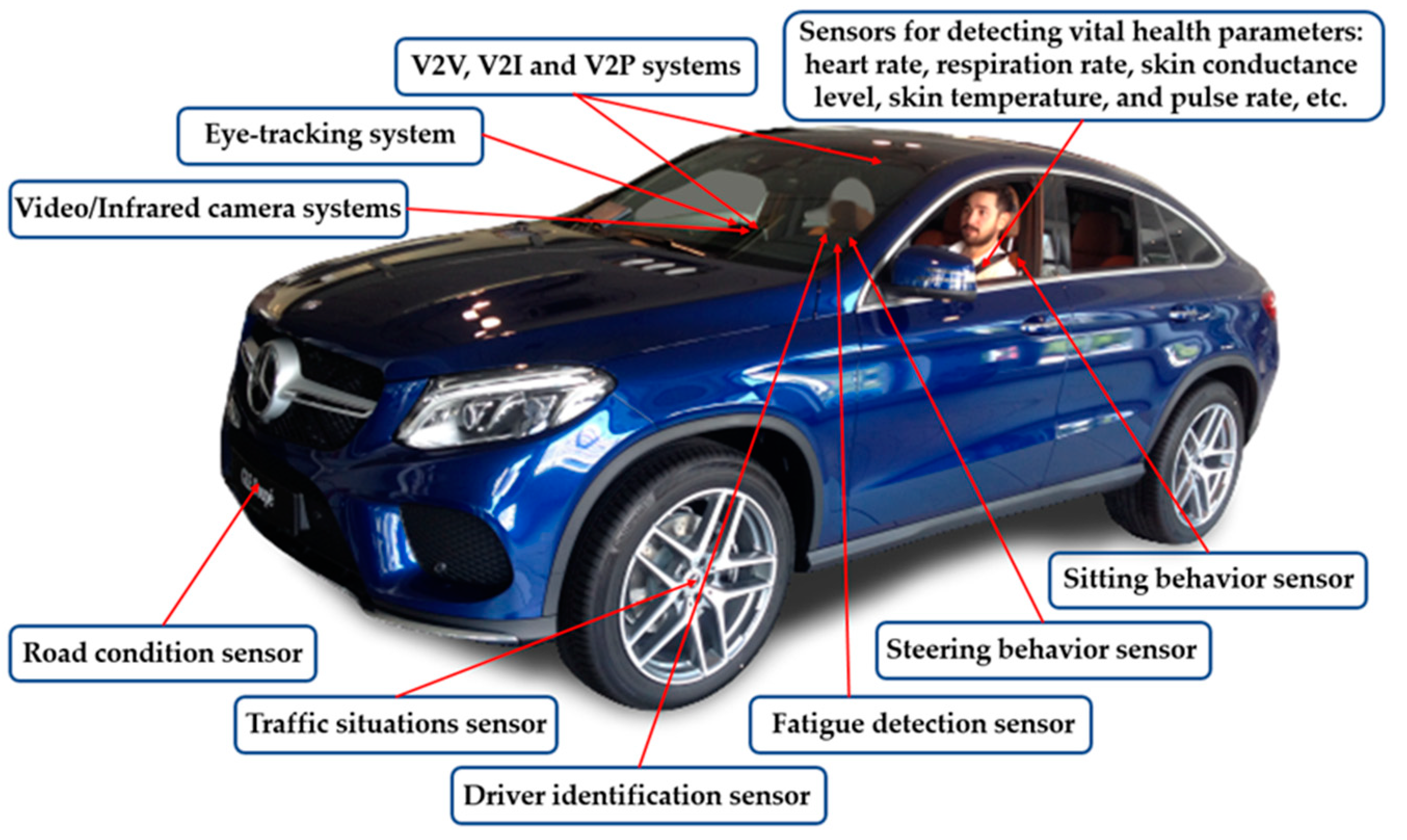
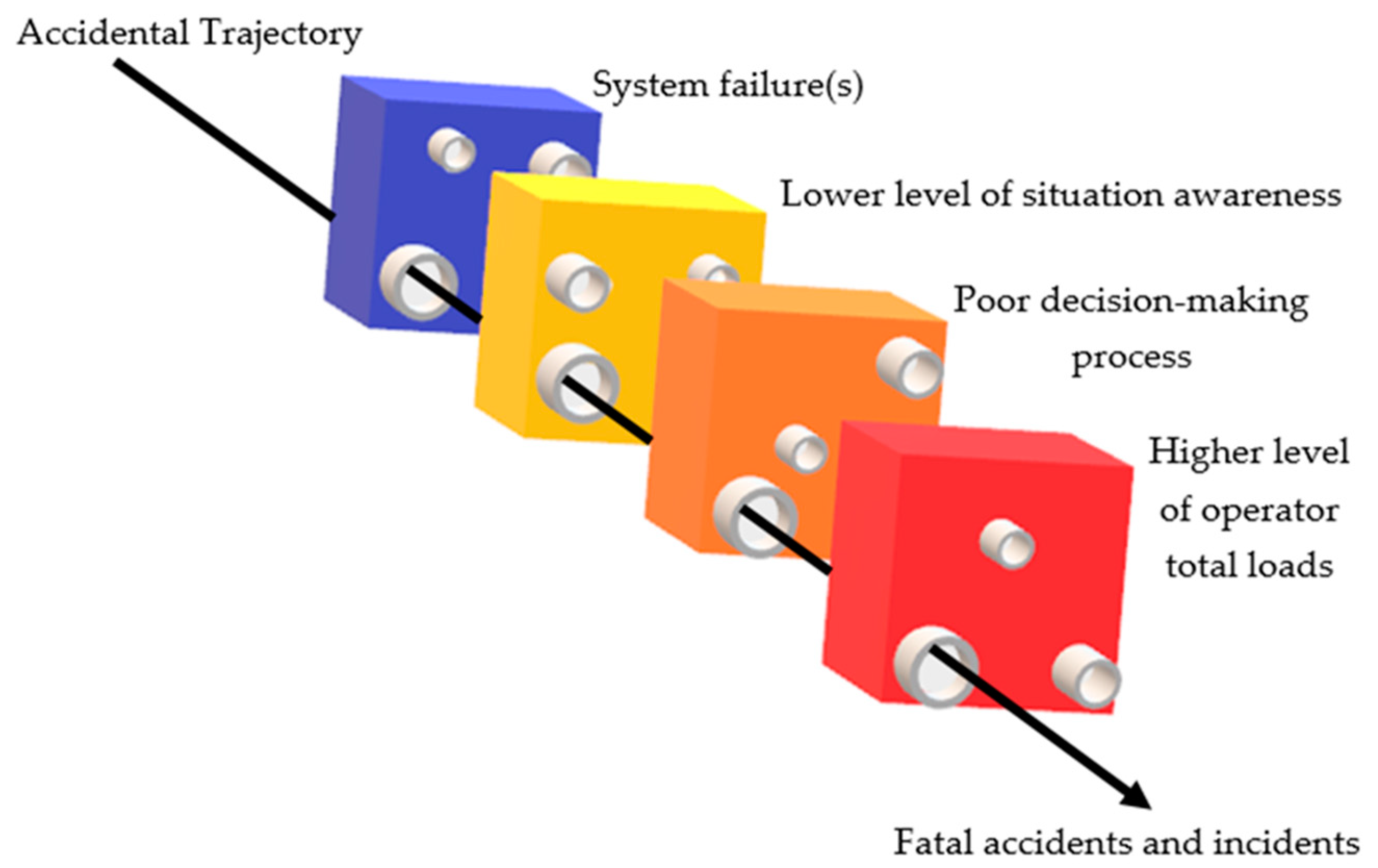
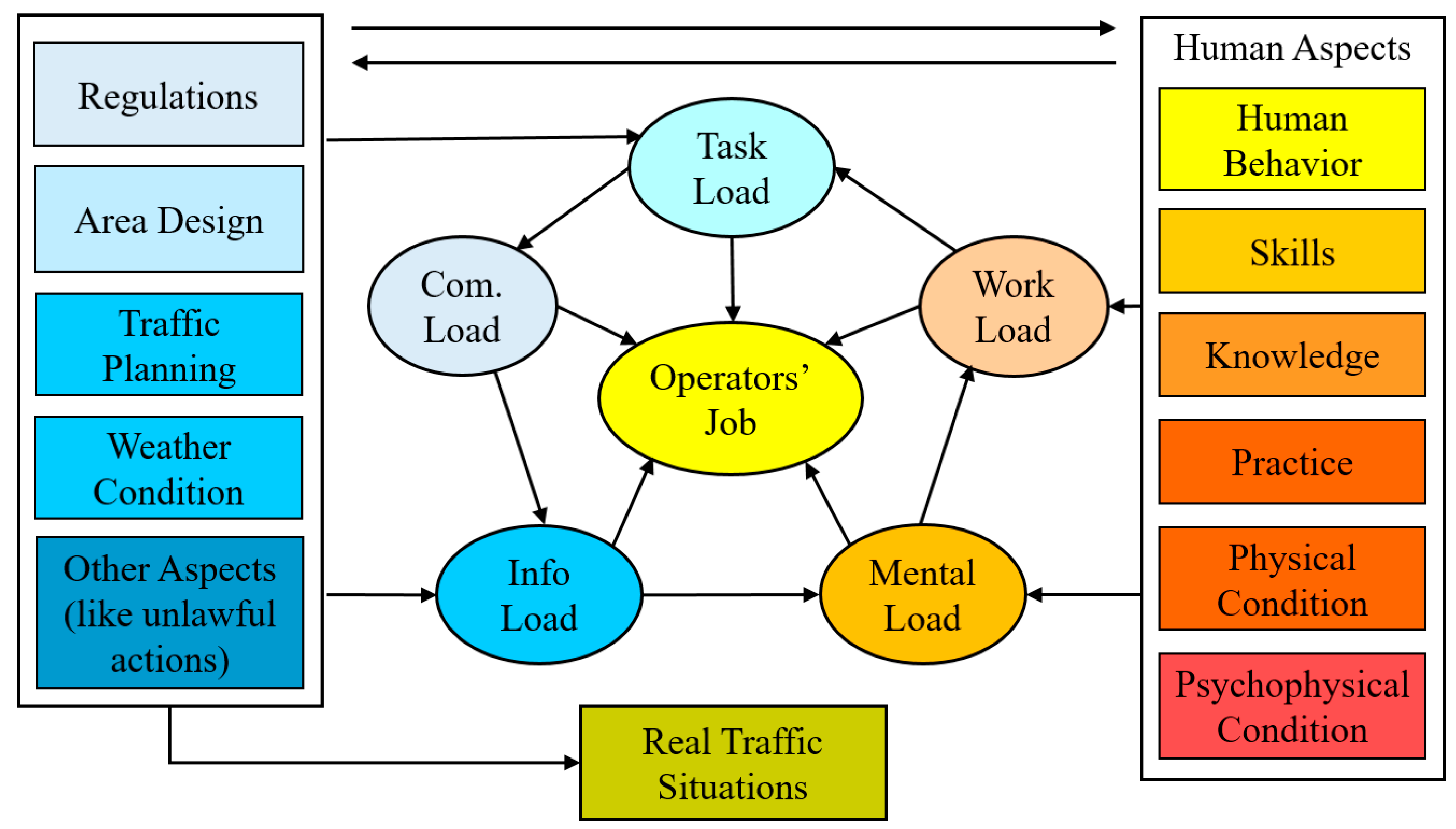

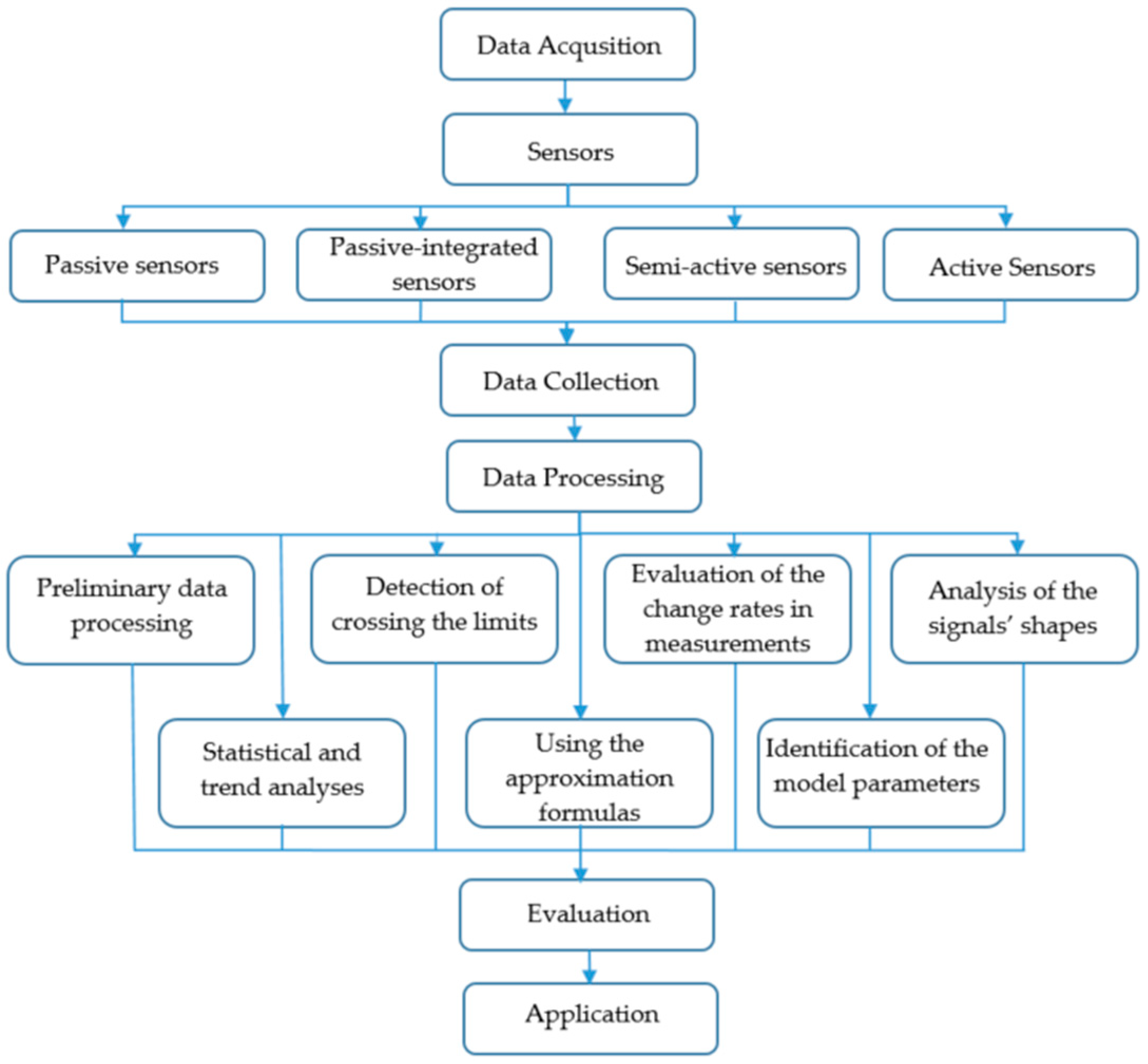

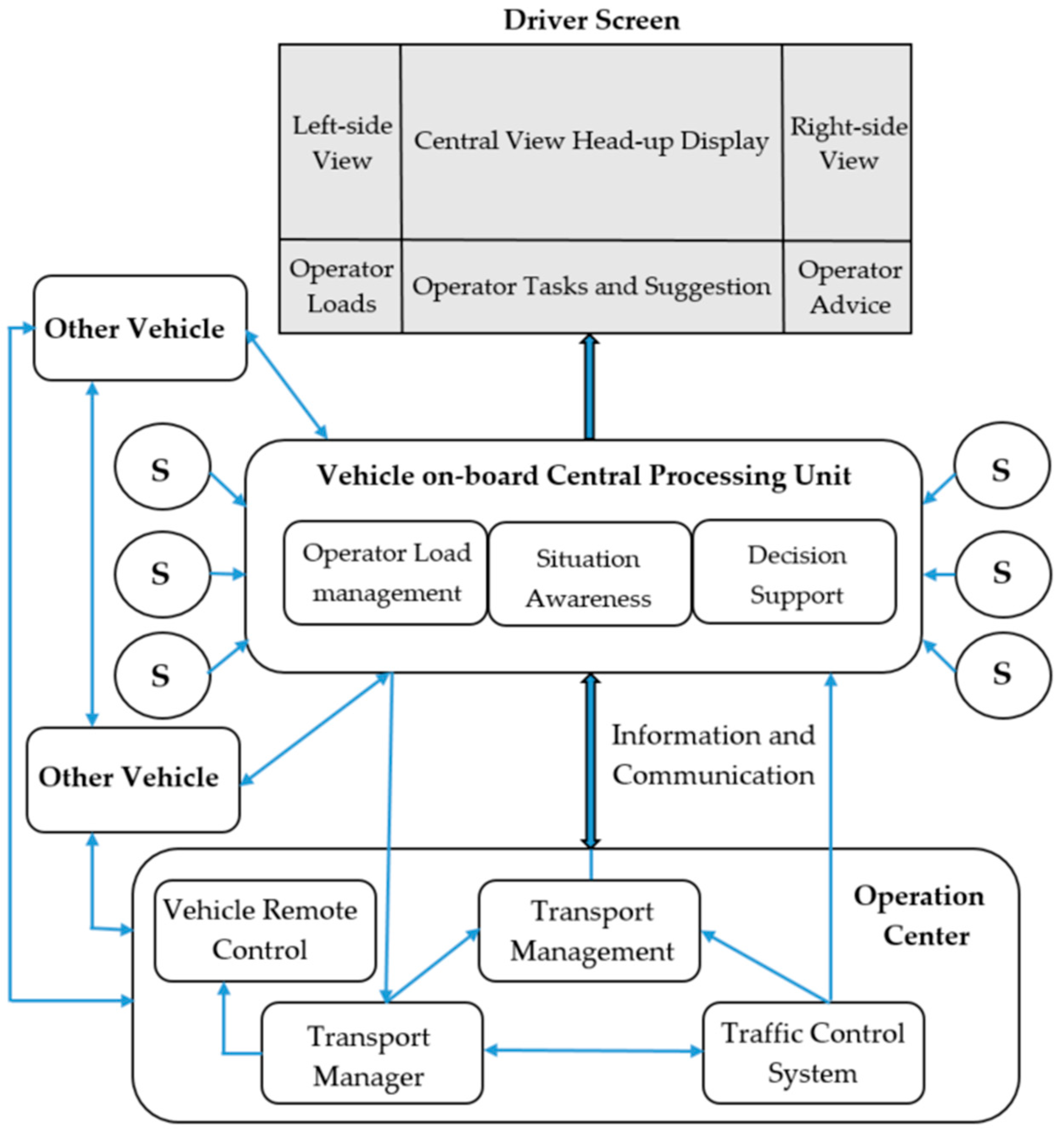

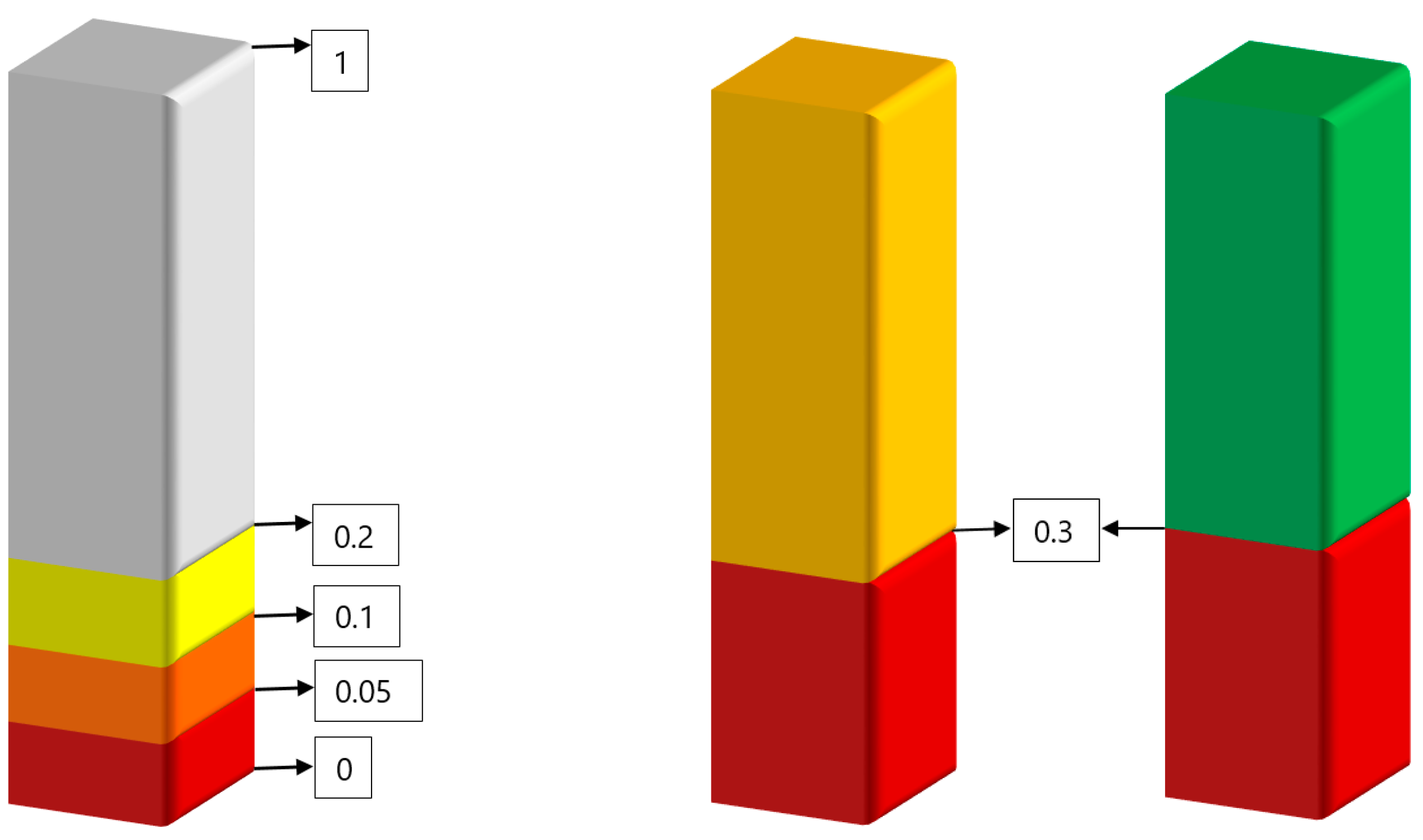
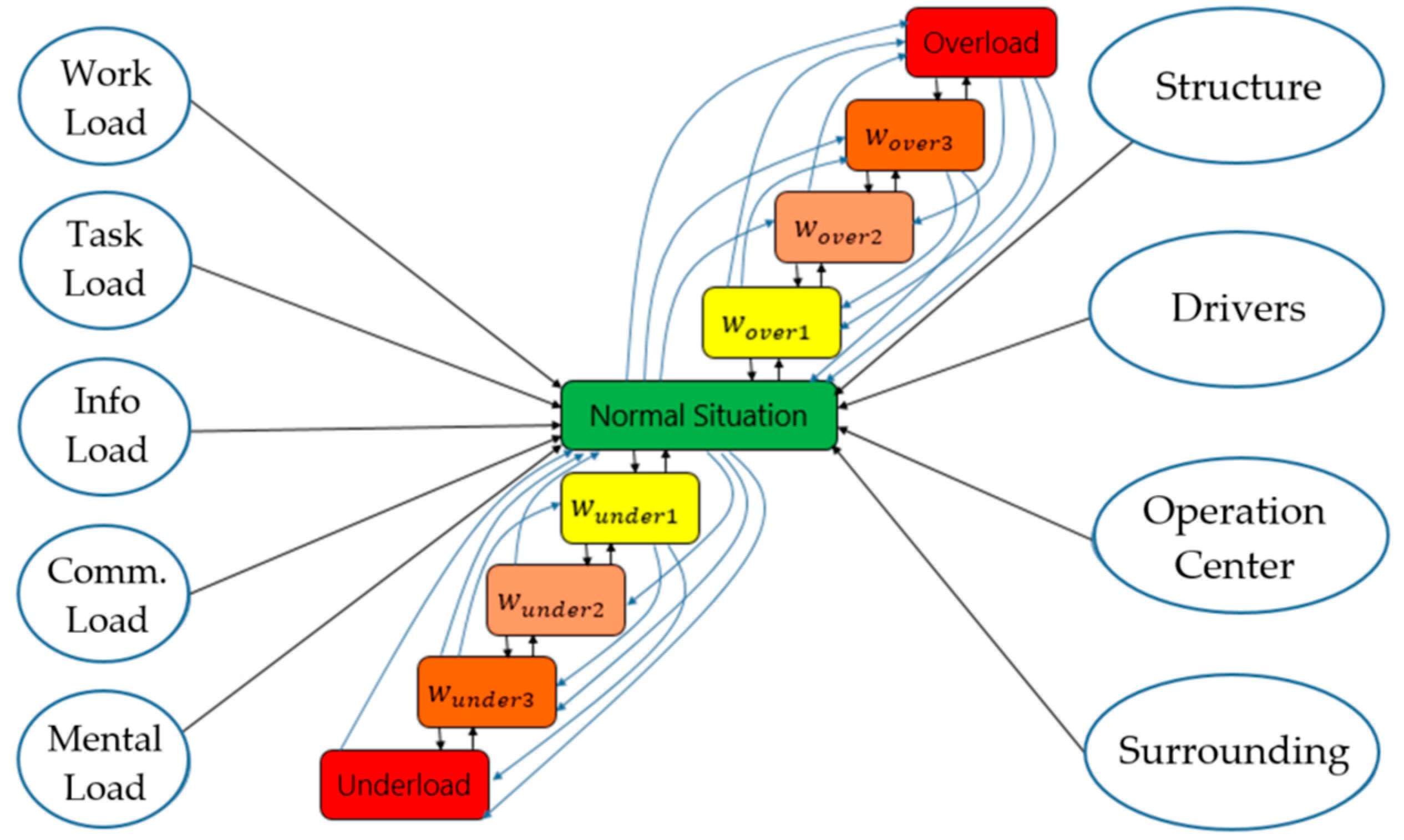
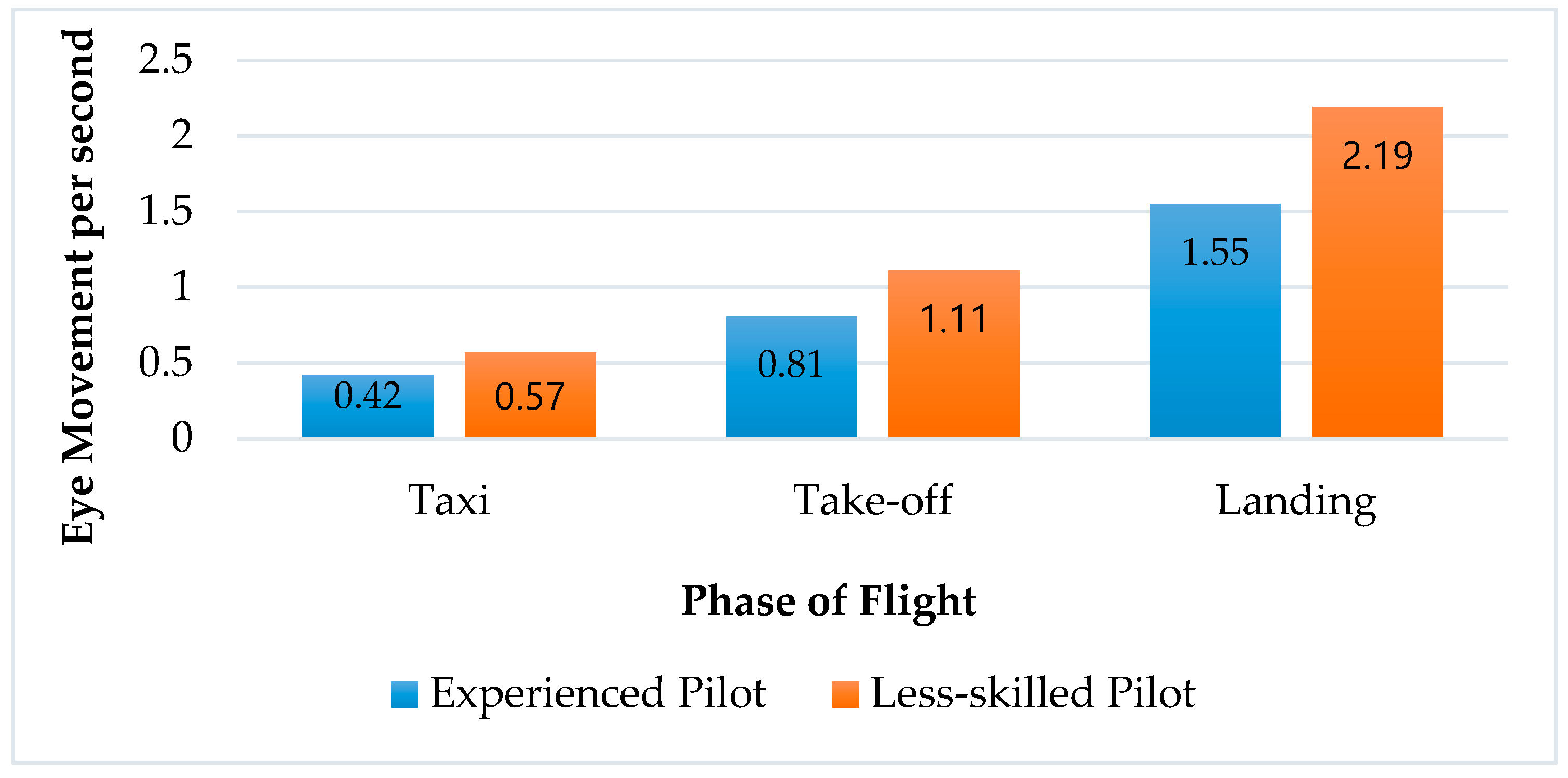
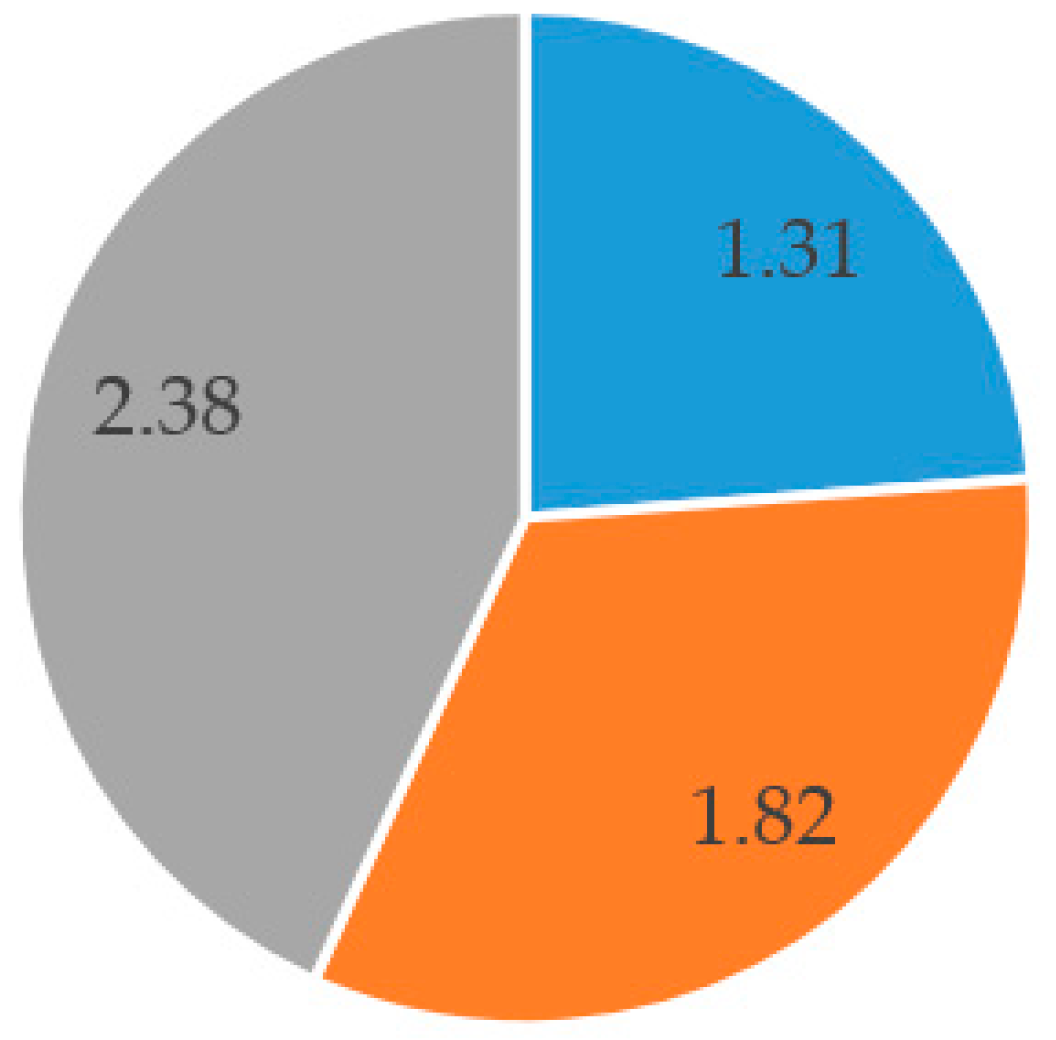
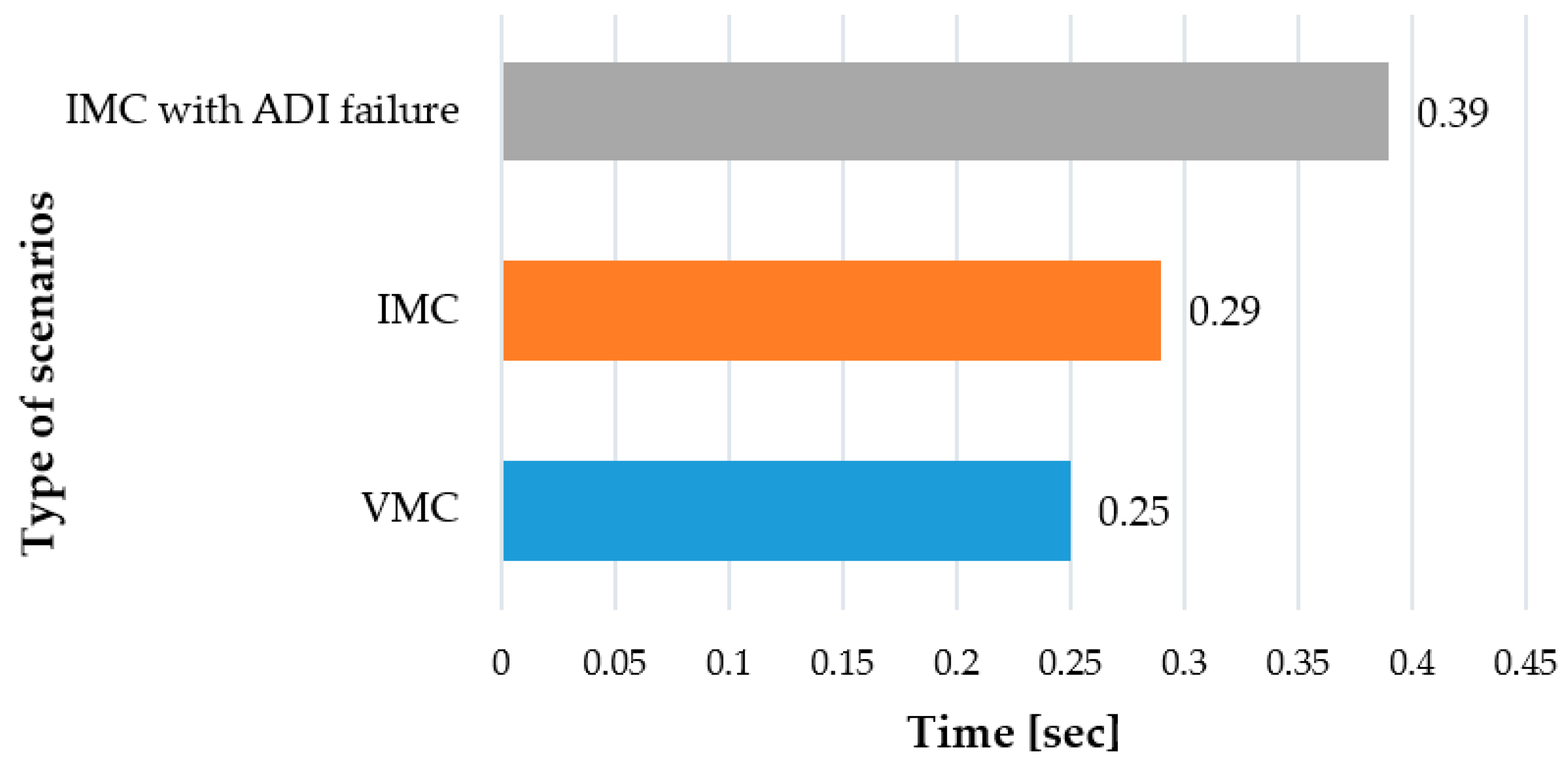
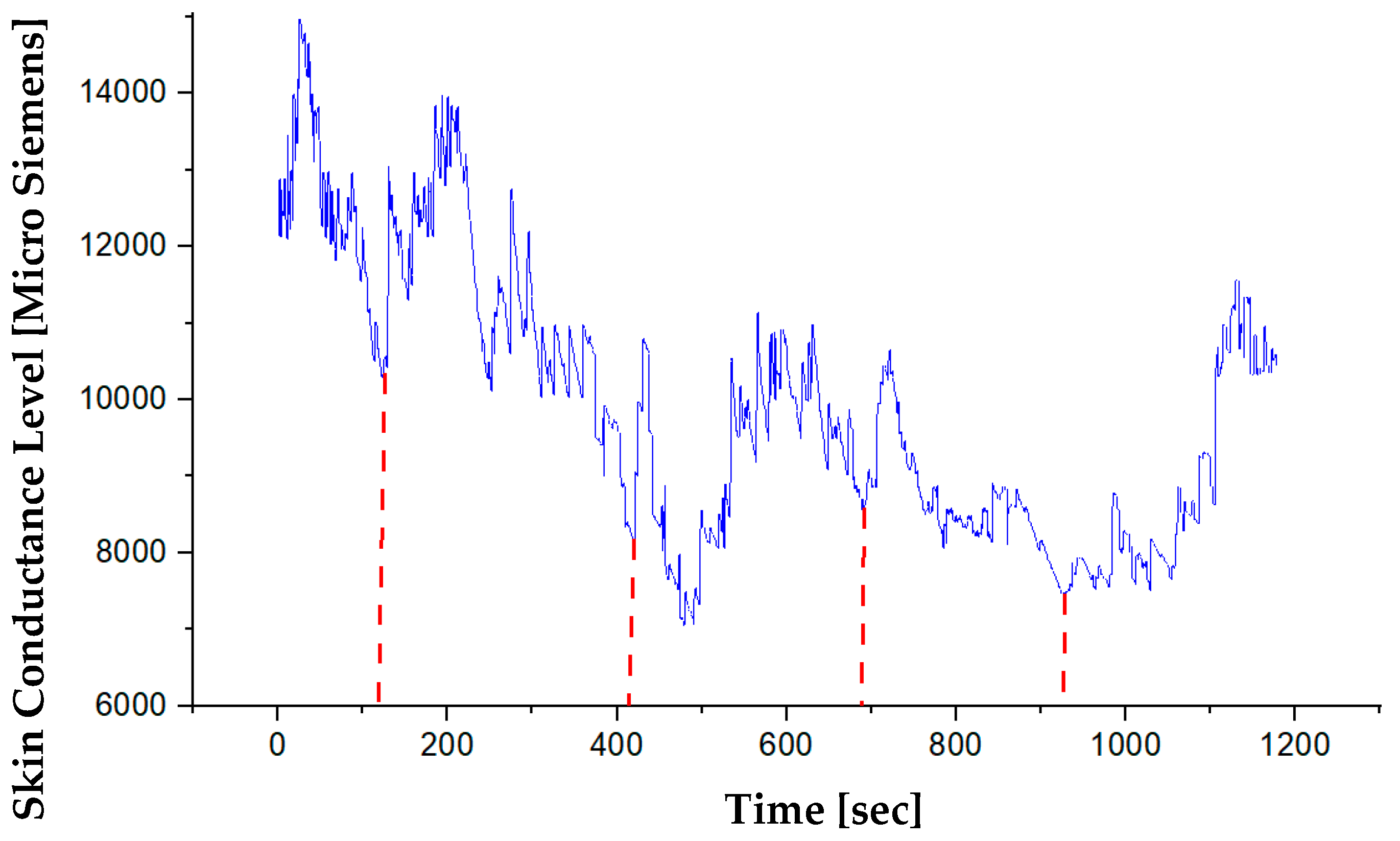
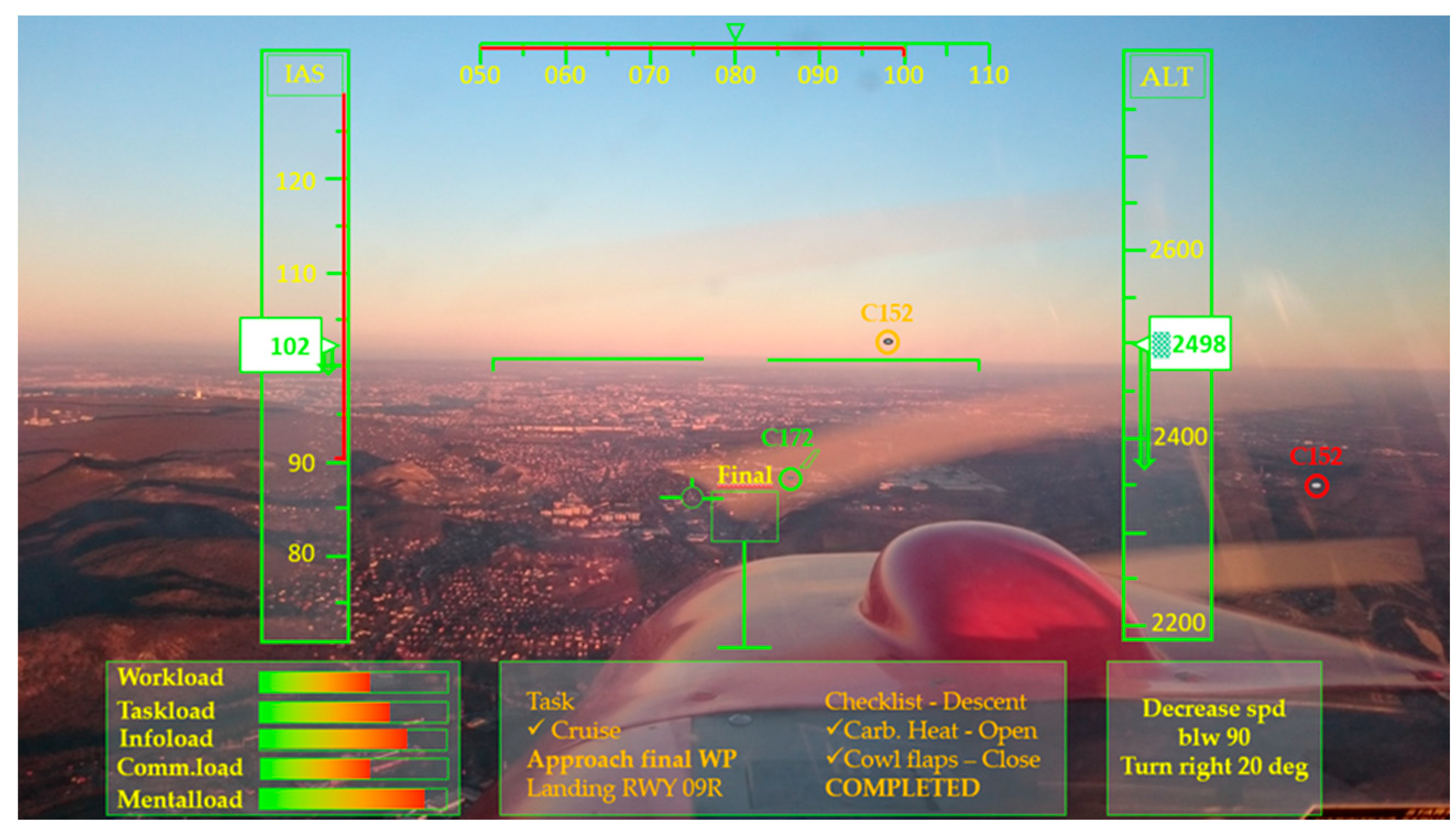
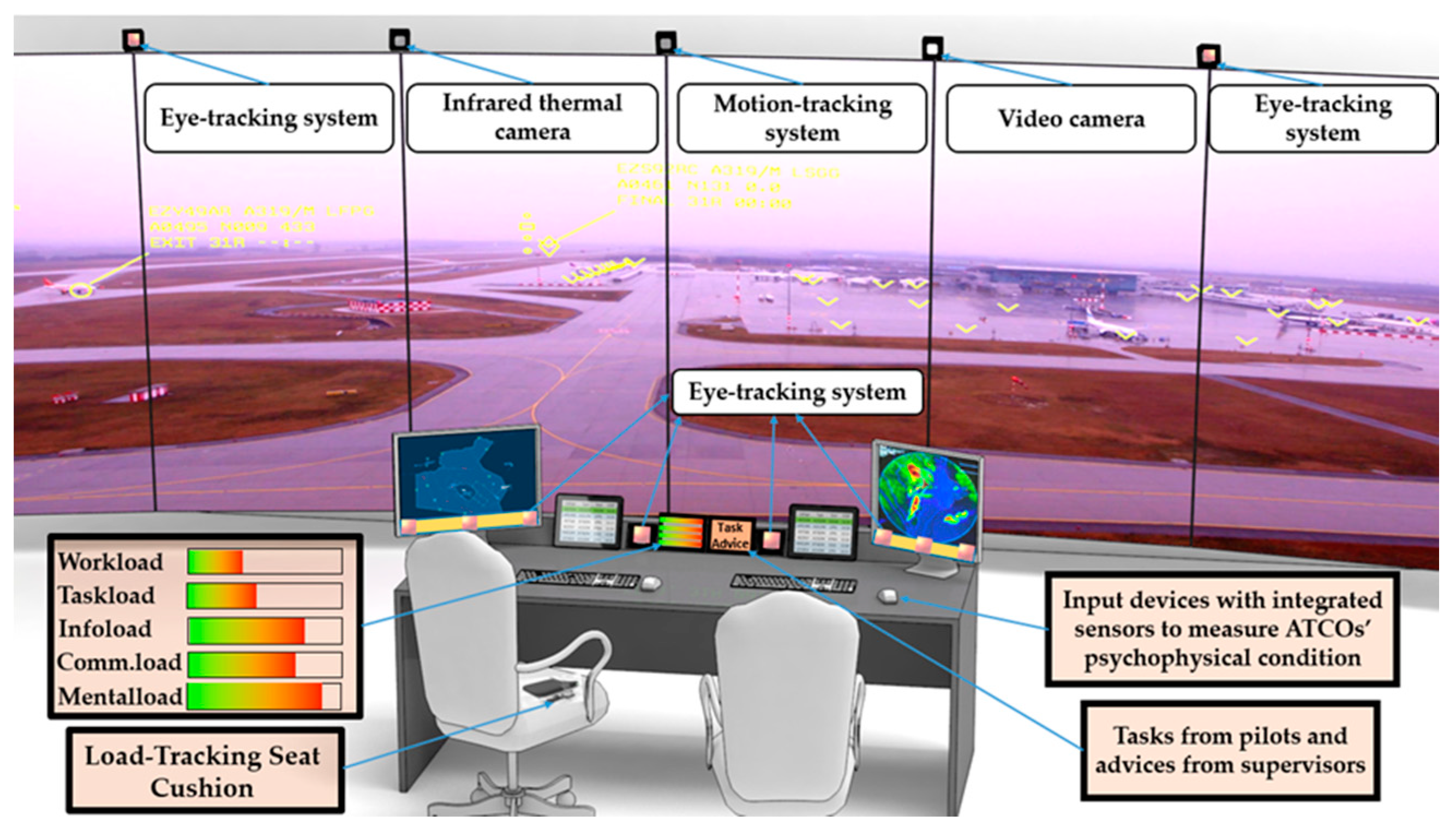
© 2020 by the authors. Licensee MDPI, Basel, Switzerland. This article is an open access article distributed under the terms and conditions of the Creative Commons Attribution (CC BY) license (http://creativecommons.org/licenses/by/4.0/).
Share and Cite
Kale, U.; Rohács, J.; Rohács, D. Operators’ Load Monitoring and Management. Sensors 2020, 20, 4665. https://doi.org/10.3390/s20174665
Kale U, Rohács J, Rohács D. Operators’ Load Monitoring and Management. Sensors. 2020; 20(17):4665. https://doi.org/10.3390/s20174665
Chicago/Turabian StyleKale, Utku, József Rohács, and Dániel Rohács. 2020. "Operators’ Load Monitoring and Management" Sensors 20, no. 17: 4665. https://doi.org/10.3390/s20174665
APA StyleKale, U., Rohács, J., & Rohács, D. (2020). Operators’ Load Monitoring and Management. Sensors, 20(17), 4665. https://doi.org/10.3390/s20174665






